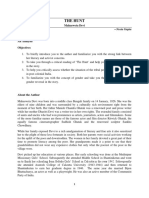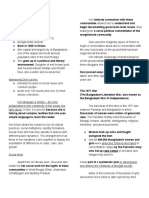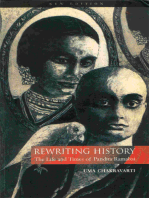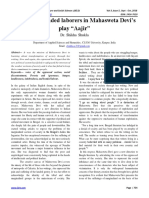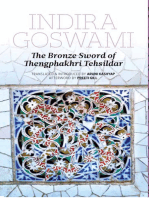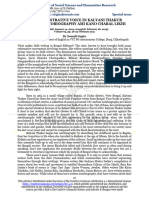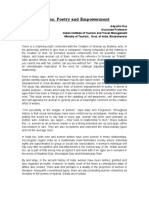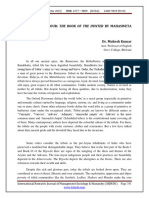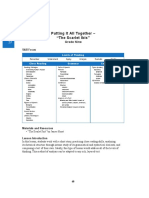Assignment 1 CC8
Uploaded by
Akhil Fayis PAssignment 1 CC8
Uploaded by
Akhil Fayis PDEPARTMENT OF ENGLISH
CENTRAL UNIVERSITY OF KARNATAKA
Assignment: 1
Title: Introduction and contribution to Mahaswetha Devi. Analysis of “The
Breast Giver”
Submitted by : Name: Arunita Patra
Reg. no. : 20PGENG01
Class: MA III Sem
Department of English
CUK,Kalaburagi
Submitted to: Renuka L. Nayak
Assistant Professor
Department of English
SHL
CUK,Kalaburagi
Date Of Submission:19th September,2021
Mahasweta Devi:-
(14 January 1926 – 28 July 2016)was an Indian writer in Bengali and an
activist. Her notable literary works include Hajar Churashir Maa, Rudali,
and Aranyer Adhikar. She was a self-proclaimed leftist who worked for the
rights and empowerment of the tribal people (Lodha and Shabar) of West
Bengal, Bihar, Madhya Pradesh and Chhattisgarh states of India.She was
honoured with various literary awards such as the Sahitya Akademi Award
(in Bengali), Jnanpith Award and Ramon Magsaysay Award along with
India's civilian awards Padma Shri and Padma Vibhushan.
Mahasweta Devi was an eminent Bengali writer and social activist,
writing in the mid-1900s, who did not shy away from pointing out the
injustices plaguing society. Apart from being a powerful novelist, she is
also remembered for her activism, having fought for the rights of the
oppressed tribal communities.In 2007, Mahasweta Devi had started writing
an autobiography. However, she could not finish it before her death. The
autobiography told stories of the mental trauma and other difficulties that
she faced. Devi was married to Bijon Bhattacharya, one of the founding
members of the Indian People’s Theatre Association. Things turned sour
when they separated in 1962. It was during this stage that she suffered
mental health issues and financial crisis.Mahasweta Devi was a woman
who dared to walk out of an unsatisfactory marriage which was a daring
move in the 60s. She sought separation from her husband in a time when it
was unthinkable to do so. As a woman, she dared to claim a space for
herself, for her writing. She endured social backlash and financial crisis
due to her decision to separate. However, she worked several odd jobs like
writing letters in English for illiterate people so that she could make ends
meet while seeking fulfillment in her writing.
Her Contributions towards literature :-
Devi’s writings are peculiarly devoid of sentimentality. She does not tug at her
readers’ emotions and is rather straightforward with her approach to talking about
the lived experiences of the marginalized. Her language is simple – an ironic
juxtaposition to the complexity of the issues she talks about. In fact, it is precise
because she is talking about complex realities that she uses simple language to
reach the reader. Her fiction allows the reader to look at cultural practices, social
institutions, identity formations, sexual roles and how they operate in spaces with
different power dynamics. The arrangement of all these in her narratives come
together to display the exploitation of differences in caste, class, and gender.
Devi’s work hints at a particular kind of change in the discourse of sexuality
where it no longer oppresses marginalized women but becomes the very ground
of political liberation. In her famous short story Draupadi, about the rape and
mutilation of a tribal woman called Dopdi, the protagonist threatens the
masculinities of her oppressors by refusing to be ashamed of her mutilated body
– forcing them to survey her nakedness with a defiance that exhibits her power
and autonomy.
Mahasweta Devi was awarded the Padma Shri, not for her work as a writer but
as an activist working with the tribal groups of the Purulia and Medinipur districts
of West Bengal.Mahasweta Devi’s writing life can be divided into significant
phases and the graph of her activities can be mapped beginning with her first
book, Jhansir Rani (The Queen Of Jhansi) in 1956, a biography of the woman
ruler in a princely state against the British in 1857. Despite lacking a research
background, Devi did meticulous research in order to write this book. She was
able to do so with help of friends and well-wishers who generously supported her
travel to the place to draw from archives, as well as documenting oral traditions
of lore and legends transmitted through generations. She wrote voraciously,
publishing 96 titles after this first book – not including her non-fiction and political
writings, children’s books and the other editing work that she was involved in
throughout her lifetime.
If 1956 was the start of Devi’s calling as a writer, she wrote in four phases. For
the reader to understand the corpus of work, the four phases are as follows:
1956-65 she published 19 titles; 1966-75, 9 titles; 1976-85, 27 titles, and her
final phase was the 1986-95, 39 titles. The second phase seems to be the
leanest amongst her writing phases. However, it is during this very phase that
she produced some of the sharpest and critical writing. The titles were Kavi
Bandyoghoti Gayiner Jivan a Mrityu (The Life and Death of Poet Bandyoghoti
Gayin), depicting the struggle of a low-caste boy in 15th century Bengal. It is
during this phase that she wrote her very well known and prolific work which was
later on adapted as a motion picture, Hajar Churashir Ma (Mother of 1084), a
story about the radical-left Naxalite movement that took place in the 1970s.
The third phase of Mahasweta Devi’s career is a marker of major changes in
terms of her creative writing as well as her political activities. It is during this
phase that she was awarded the state sponsored Sahitya Akademi Award for her
work titled Aranyer Adhikar (Rights to the Forest). From then on, her fiction
subjects were the socially marginalized, the poor and neglected tribals and their
struggles. Her intimate knowledge of what transpired on the ground allowed her
to weave stories to bring these struggles into the mainstream. Among Indian
languages, her work has been translated into Marathi, Hindi, Assamese, Telugu,
Malayalam, Punjabi, Oriya, Gujarati and Ho, a tribal language. She has also
been translated into English, Italian, French and Japanese.
The third phase of Devi’s work was more expansive. Though she was traveling
profusely to the tribal regions of Bihar and West Bengal, she felt the need to
communicate to a wider audience to speak of what was happening to people in
countryside in the name of development. She wrote in newspapers and journals
during this period, because fiction was no longer an adequate medium to convey
the political and social struggles she was witnessing during her travels and her
interaction with the people of marginalised communities. The various areas she
wrote on included the identity and dignity of the poor, their struggles of survival,
ecology, and environment, informal sector and minimum wage, and literacy and
education.
The fourth phase of Mahasweta Devi’s work kept growing and she was rigorously
involved in activism and continuously writing for the causes she believed in. She
was preoccupied with the issues of mainstream development and the
consequent marginalization of certain populations and the environment. While
genteel Bengali literature glossed over the problems of Dalits and Adivasis,
Mahasweta Devi used her position of privilege to actively amplify their voices and
struggles. So dear was she that was called ‘Ma’ (mother among the Kheria
tribals) or ‘Marang dai’ (sister among the Santhals).
Devi wrote profusely on the issues of mainstream development and
critiqued the trickle-down theory. Her work is important to understand subaltern
politics and their struggles to visiblize their invisiblized exploitation. She was
associated with several organisations and founded several others. She is as
comfortable leading the processions of the people fighting for the rights of
bounded labourers as she is behind her desk writing about these struggles.
Mahasweta Devi, the activist, has been constantly involved in varied struggles
and was a part of several associations in spite of the demands of her increasing
age. She played these varied roles throughout her life and the activist in her was
alive and resisting till her last breath.
Several of her short stories and novels have been adapted into film features.
Bollywood movie Sangharsh and Rudali were based on her books. Sangharsh
was based on Layli Asmaner Ayna, and Rudaali was based on novel Rudaali.
Bayen, a Hindi film, was based on a short story. Similarly, movies Maati Maay,
Gangor, and Ullas were based on short stories Baayen, Choli Ke Peeche and
Daur, Mahadu Ekti Rupkatha, and Anna Aranya respectively.
The Breast Giver:-
In her story, “The Breast Giver,” from her collection of short stories called,
“Breast Stories,” Mahasweta Devi outlines women’s identity as body, worker and
object. In a tale of a Bengali wet-nurse, Devi shows female protagonist, Jashoda,
living in a 1960’s India as she is compelled to take up ‘professional motherhood’
when her Brahman husband loses both his feet.
With her only ability held in her ‘always full’ breasts and her desperate economic
destitution — she is swiftly utilized and praised for her expert weaning of wealthy
offspring, which she does for 25 years, before losing her usefulness and
consequently dying from breast cancer.
Mahashweta Devi’s ‘Standayini’ or ‘Breast Giver’ is a hard-hitting story of a
“professional mother” who suckles the babes of a rich household only to meet an
ironic end when all her “milk-sons” grow up, leaving her breasts redundant and
rankled with cancer.
The story recognises several problems with women’s position in a post-colonial
India. On one hand, women are idolized, almost worshipped – the female
protagonist Jashoda (named after the paragon of motherhood, Yashoda) is often
referred to as the “Lionseated” and the “Mother of the world”; other servants in
the household wash her feet and drink that water. Once the object of intense lust
and desire due to her ample bosom, Jashoda’s profession transforms her into a
Goddess overnight.
Women also enslave themselves by adhering to this image imposed upon them.It
is only at the very end when Jashoda is abused by her husband and neglected
by her sons, does she really abandon them, both physically and emotionally. She
realises that none of her children, biological or surrogate, will be there for her as
she breathes her last.
So Jashoda, along with other women around her, is first exploited and then
rendered useless, at times by men but surprisingly often by other women. As
Tarishi, one of our readers pointed out, all the women are “short-changed, in one
way or the other, and by one another in a sad way, they are each responsible for
the dispensability and commodification of another of their own kind”; The
Mistress of the Haldar household encourages Jashoda to keep bearing children
so she can produce milk, the step daughters eventually turn her out, the “other
woman” steals her husband and the maids become neglectful and disrespectful
towards Jashoda as she comes to terms with her loss of status.
In the end, the festering sores on Jashoda’s cancer-infested breasts drive away
her briefly-guilty husband and all her “milk-sons' ' whom she had helped raise.
None of her own daughters or the Haldar daughters in law come to see her. She
is left all alone with her confused thoughts and regrets.Breast-Giver’ is a powerful
and provocative read, highlighting the complexity of women’s identities in times
of social flux.
When Kangali is rushed to the hospital, the elder Haldar is mortified at the
thought of having a Brahmin killed from his namesake’s hand. Haldar assures his
victim Don’t worry, son! You won’t suffer as long as I‟m around”.
Thought this promise comes as a relief to the now mangled priest, it is not him
whose survival is truly threatened – he is after all of the highest caste in what
Devi calls in her story, independent India, the India that makes no distinctions
among people Varieties of Brahmin ” Even though Haldarbabu makes his fortune
in the British era of “divide and rule” he exclaims, “There’s no East or West for a
Brahmin”.
Without his feet Kangali‟s security is mostly assured by his spiritual standing.
Though times become desperate after his wealthy benefactor dies, he could just
as easily move on to another temple where he is unencumbered by his family, as
he goes on to do so later in the story. It is Jashoda whose survival is seriously
jeopardized by the castration of her husband‟s feet and then the death of their
patron, lacking as she is of anything monetarily or spiritually relevant to a
patriarchal culture – save for her prophetic lactation, her ever flowing supply of
breast milk.
In producing heirs, husbands of the house wish to preserve their bride‟s beauty –
and this becomes the „deal-sealing‟ point for Jashoda‟s induction into
professional motherhood. The mistress of the house decides that this proposal of
employment is “worth a million rupees” because daughter- in-laws will be
mothers. And most importantly, will be mothers for as long as possible Even
though progressive suckling will “ruin a mother‟s shape”. If sons look outside
there is no voice to object. “Going outside because they can‟t get it at home, this
is just”, the mistresses proclaim. As the wife, through her gift of reproduction
becomes objectified in the market as commodities, and her husband as
consumer expects an endless supply to satisfy his insatiable
almost childlike desire for both „trophy and tool‟, the wife knows, as a woman she
must take on the subordinate role of simultaneously pleasing and producing for
her masters.
“Such is the power of the Indian soil that all women turn into mothers here and all
men remain immersed in the spirit of holy childhood”, writes Devi. This theme of
oppressive hegemony, built into both spiritual practice and economic belief,
resonates in all of the narratives of the women in, “Breast Stories”.
In the “Breast Giver”, as Jashoda becomes more and more revered for her
body‟s other worldly tolerance, it seems as though the binary is moving towards
free play – from man /woman to a hierarchy closer to woman/man. Both
Brahmans in their own right, Kangali shares home tasks as he takes on the
cooking at home and cares for their three children as Jashoda is heralded as
wet-nurse and, “the mother of the world”.
Jashoda’s only usefulness in the male dominated cultural setting is her maternal
plenitude, her duty of raising children out of an imaginary order as she dives into
the symbolic law of the father. This usefulness is the responsibility of all mothers
of patriarchy. As she extends her task to countless children, other than her own,
Jashoda becomes “Martyr” – a role that suggests both significance and sub-
ordinance, and even worship, while she simultaneously secures her never ending
lack of milk and nourishment. That she willingly keeps emptying herself for the
‘good of man’ makes it possible to revere her without ultimately revising her
underprivileged charge.
In this way this story will float over feminisms to come across the female
resistance and the different modes of female struggle to identify the female
position in their location and situation. It is the part of the subaltern context where
female identity is rarely counted. The main focus will be to justify subaltern
female identity with the referential text of Mahasweta Devi’s story, “Standayani
(Breast Giver)” as a representational art. It will locate the localized values of
female essences rather that the modes of feminisms for political and social
equality. It will try to examine whether the power bodily performance and
professional mode of bodily act could define difference of female resistance or
not. I will be trying to explore the various frameworks of female struggle and
modes identity formation with Mahasweta Devi’s “Breast Giver” which I will be
interchangeably using for “Standayani.” It is a localized version of female study
with subaltern references and female study. Subaltern Female study could lead a
different mode for study where rather that looking at binary positions of
male/female, we study them with their own narratives. In this paper, it will be
attempted that the growth of those people who are conscious on their ways of
living without being compared to higher class of people. I will be looking at the
position of other marginalized females and their attempt to hold the position to
compare and contrast subaltern females and their collectiveness. I will be
referring the subaltern female of Mahasweta Devi‟s “Standayani” as my primary
source. Whereas theoretical modes will be taken from Spivak, Gramsci.
Here is mode of feminist study will be re-reading female identity with reference to
subaltern female position. Subalternity could be analyzed as marginalized or
other figures as their essence is under shadow. They are not visible in the space
of center or main stream. In this context they grow with their own stories and
narratives which collaborate build their values. I have tried to explore the power
of resistance and bodily acts of those shadowed females. It is reflected in their
manner of acceptance and the collective consciousness in regard to their social
position. Mahasweta Devi’s “Standayani” and “The Five Women” are the text to
refer and justify the mode of subaltern female identity.
In this subaltern location, females are having their position within the boundary of
their family needs and survival forces. The female modes differ for locating the
female identity. They grow with their power of resistance as they use their bodily
performative acts as means of devaluing the power's existence. Spivak uses the
“Breast Stories”of Mahasweta Devi to explain the position and real existence of
females in the context of the unheard situation of the group. Jashoda in
Mahasweta Devi’s story, Standayini (Breast Giver),makes her presence and
existence as a breast feeder and a source of survival for her paralyzed husband.
They grow with the strength of resisting the power politics without revolt. In this
mode female struggle and resistance, feminism gets different outlook as for
localized female version of identifying themselves. We need to refer the
feminisms which raise the issue of gender as the basis for the organization of
society; there were various debates and struggle in female movements. The
basic component in every modes of female identity formation is heading forth for
equality with male or for establishing the differences with men. These trends
have brought female right debates rather than exploration of true identity. In a
continuum of female movements we get liberal females who searched for equal
rights and radical females who insisted the differences as their identity marker. In
every steps of female discourse we find the attempt to get political visibility in the
world.Female experience is embodied in the female subject. As said before,
women in (post) colonial cultures have been termed „the twice colonized‟, both
by the imperial and the male social order. As such, women and the colonized are
seen as sharing an experience of oppression and subjugation that has
constructed their very beings.10this mode of female essence makes the way for
discussing about the subaltern group. It is not identity formation in terms with
cultural, ethnical or any other social marker but their own silent way of gestures,
rumors and collective efforts. It could be seen as resisting and reconstructing
modes where they either live with a communal mode or as simplemindedness
attitude just bothering their own periphery. This paper will justify that subaltern
female existence is built with more reverent stature which makes the people in
power worthless.
The class believed that Jashoda was exploited through her profession because
she was a woman, and that the Haldar family was using Jashoda‟s body for their
benefit. I, however, believe that Jashoda was exploited because of the class
structure. To a certain extent, the Haldar household was using Jashoda‟s body,
but religion and culture also helped others realize that her new profession is a
positive milestone in her life. The female body has the reproductive system to
nurture and rear children, and Indian women are seen mostly as mothers, by
profession. Jashoda is not exploited because she is a woman; instead, she is
exploited because of the class structure and the change of time and the
circumstances lead to her puzzling fate.
The culture and religion help represent Jashoda‟s profession positively. Jashoda
has a dream where the Lion seated comes to her as a midwife. At first, the
interpretation of the dream is confusing; however, when Jashoda accepts her
profession at the Haldar household, people in the neighborhood, including Nabin,
the pilgrim guide, realize that her dream was a prophesy of her future. Astrology,
dreams, and spiritual connections with the gods and goddesses are taken very
seriously in the Indian culture;therefore, the Lion seated entering Jashoda‟s
dream as a midwife helped legitimize and highlight the importance of Jashoda‟s
new profession. It is described in the story, “Thus even the skeptics were
persuaded that the Lion seated had appeared to Jashoda as a midwife for this
very reason”. The Lion seated coming into her dream is a very important sign
that shows she is not being subjugated or used by others because she is a
woman who can rear children, but that it was her fate chosen by God. The story
also mentions that “Faith in the greatness of the Lion seated was rekindled in the
area and in the air of the neighborhood blew the electrical fying influence of
goddess-glory”. Jashoda helped revive the faith in the Lion seated. She
represented a living form and the glory of the Lion seated, and because of that
“everyone‟s devotion to Jashoda became so strong that at weddings, showers,
naming, and sacred-threading they invited her and gave her the position of chief
fruitful woman”. Her connection with the Lion seated elevated her status and
made her important in the neighborhood. Inviting Jashoda is similar to inviting the
Lion seated. The maids praised her by saying, “Joshi! You came as The
Goddess! You made the air of this house change”. Even the children who were
reared on Jashoda‟s milk were called the Holy Children. This helped the status of
the Haldar children and her own because they were seen as the ones who
suckled from the Holy Mother.
References:-
1-Mahasweta Devi. “Breast-Giver.”Trans. Gayatri Spivak.
2-Spivak, Gayatri Chakravorty. “French Feminism in an International
Frame.”
3-https://www.ijsr.net/archive/v9i2/SR20211113132.pdf
You might also like
- The Wise Woman and Other Stories: The Best of Mannu BhandariFrom EverandThe Wise Woman and Other Stories: The Best of Mannu BhandariNo ratings yet
- A Critical Analysis of Mahasweta Devi WritingNo ratings yetA Critical Analysis of Mahasweta Devi Writing13 pages
- 2020ballb24, English Project Semester-2 Mid TermNo ratings yet2020ballb24, English Project Semester-2 Mid Term14 pages
- Article On Maha Swethadevi Breast GiverNo ratings yetArticle On Maha Swethadevi Breast Giver16 pages
- The Feminine and the Familial: A Foray into the Fictional World of Shashi DeshpandeFrom EverandThe Feminine and the Familial: A Foray into the Fictional World of Shashi DeshpandeNo ratings yet
- Dynamics of Defiant Gendered Subaltern in Mahasweta Devi'S Draupadi'No ratings yetDynamics of Defiant Gendered Subaltern in Mahasweta Devi'S Draupadi'8 pages
- A Life in the World: U.R. Ananthamurthy in Conversation with Chandan GowdaFrom EverandA Life in the World: U.R. Ananthamurthy in Conversation with Chandan GowdaNo ratings yet
- The Role of Women's Memoirs in Bengali and World LiteratureNo ratings yetThe Role of Women's Memoirs in Bengali and World Literature5 pages
- Mahasweta Devi Writer Activist Visionary Writer in Context 1st Edition Radha Chakravarty Editor download100% (1)Mahasweta Devi Writer Activist Visionary Writer in Context 1st Edition Radha Chakravarty Editor download76 pages
- Unclaimed Harvest: An Oral History of the Tebhaga Women's MovementFrom EverandUnclaimed Harvest: An Oral History of the Tebhaga Women's MovementNo ratings yet
- Plea To The Bonded Laborers in Mahasweta Devi's Play "Aajir"No ratings yetPlea To The Bonded Laborers in Mahasweta Devi's Play "Aajir"7 pages
- Rudali_From_Fiction_to_Performance_Mahāśvetā_Debī,_Usha_GanguliNo ratings yetRudali_From_Fiction_to_Performance_Mahāśvetā_Debī,_Usha_Ganguli161 pages
- 171-The Remonstrative Voice in Kalyani Thakur Charal-1625310434No ratings yet171-The Remonstrative Voice in Kalyani Thakur Charal-16253104344 pages
- Adversity of Women in Girls Burn BrighterNo ratings yetAdversity of Women in Girls Burn Brighter31 pages
- Where can buy Mahasweta Devi Writer Activist Visionary Writer in Context 1st Edition Radha Chakravarty Editor ebook with cheap price100% (7)Where can buy Mahasweta Devi Writer Activist Visionary Writer in Context 1st Edition Radha Chakravarty Editor ebook with cheap price31 pages
- Cultural Studies in Rudali - A Perspective of Mahasweta DeviNo ratings yetCultural Studies in Rudali - A Perspective of Mahasweta Devi5 pages
- Naxalite Movement As A Millennium Satan in Mahasweta Devi's Mother of 1084No ratings yetNaxalite Movement As A Millennium Satan in Mahasweta Devi's Mother of 10846 pages
- Reinterpreting Myth in Mahasweta Devi's "Draupadi"No ratings yetReinterpreting Myth in Mahasweta Devi's "Draupadi"3 pages
- A Search For Honour The Book of The HuntNo ratings yetA Search For Honour The Book of The Hunt6 pages
- Translating Marginality Bayen Major SeminarNo ratings yetTranslating Marginality Bayen Major Seminar12 pages
- Feministic Perspectives through Gender Discrimination Represented in RUDALI by Mahasweta DeviNo ratings yetFeministic Perspectives through Gender Discrimination Represented in RUDALI by Mahasweta Devi3 pages
- The Elizabethan Era and Shakespeare's Women Characters in The Public ArenaNo ratings yetThe Elizabethan Era and Shakespeare's Women Characters in The Public Arena12 pages
- Chapter 1: The Early Married Life of The Morels: Sons and LoversNo ratings yetChapter 1: The Early Married Life of The Morels: Sons and Lovers4 pages
- Half Yearly Questions Paper Class 11 ChemistryNo ratings yetHalf Yearly Questions Paper Class 11 Chemistry2 pages
- Test Bank For Atando Cabos: Curso Intermedio de Español, 4/E 4th Edition María González-Aguilar, Marta Rosso-O'Laughlin100% (1)Test Bank For Atando Cabos: Curso Intermedio de Español, 4/E 4th Edition María González-Aguilar, Marta Rosso-O'Laughlin48 pages
- Translating Childrens Illustrated Story Books ChaNo ratings yetTranslating Childrens Illustrated Story Books Cha11 pages
- 15korean TamilLanguageandCulturalinternationaljournalNo ratings yet15korean TamilLanguageandCulturalinternationaljournal10 pages
- (Presentation) P Lesson 1 Introduction To LiteratureNo ratings yet(Presentation) P Lesson 1 Introduction To Literature17 pages




